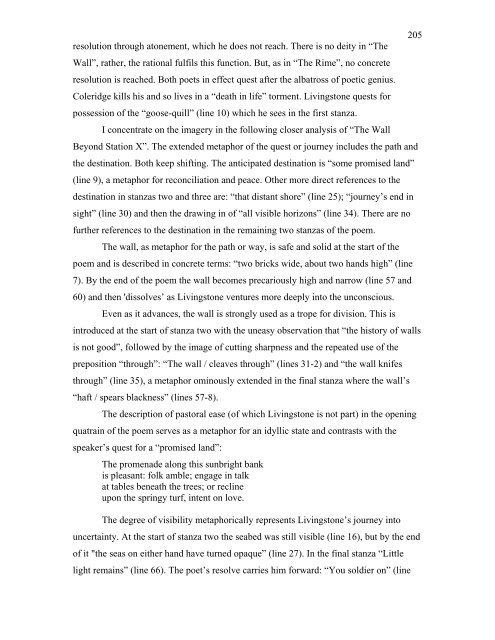"Symbiosis or Death": - Rhodes University
"Symbiosis or Death": - Rhodes University
"Symbiosis or Death": - Rhodes University
You also want an ePaper? Increase the reach of your titles
YUMPU automatically turns print PDFs into web optimized ePapers that Google loves.
205<br />
resolution through atonement, which he does not reach. There is no deity in “The<br />
Wall”, rather, the rational fulfils this function. But, as in “The Rime”, no concrete<br />
resolution is reached. Both poets in effect quest after the albatross of poetic genius.<br />
Coleridge kills his and so lives in a “death in life” t<strong>or</strong>ment. Livingstone quests f<strong>or</strong><br />
possession of the “goose-quill” (line 10) which he sees in the first stanza.<br />
I concentrate on the imagery in the following closer analysis of “The Wall<br />
Beyond Station X”. The extended metaph<strong>or</strong> of the quest <strong>or</strong> journey includes the path and<br />
the destination. Both keep shifting. The anticipated destination is “some promised land”<br />
(line 9), a metaph<strong>or</strong> f<strong>or</strong> reconciliation and peace. Other m<strong>or</strong>e direct references to the<br />
destination in stanzas two and three are: “that distant sh<strong>or</strong>e” (line 25); “journey’s end in<br />
sight” (line 30) and then the drawing in of “all visible h<strong>or</strong>izons” (line 34). There are no<br />
further references to the destination in the remaining two stanzas of the poem.<br />
The wall, as metaph<strong>or</strong> f<strong>or</strong> the path <strong>or</strong> way, is safe and solid at the start of the<br />
poem and is described in concrete terms: “two bricks wide, about two hands high” (line<br />
7). By the end of the poem the wall becomes precariously high and narrow (line 57 and<br />
60) and then 'dissolves’ as Livingstone ventures m<strong>or</strong>e deeply into the unconscious.<br />
Even as it advances, the wall is strongly used as a trope f<strong>or</strong> division. This is<br />
introduced at the start of stanza two with the uneasy observation that “the hist<strong>or</strong>y of walls<br />
is not good”, followed by the image of cutting sharpness and the repeated use of the<br />
preposition “through”: “The wall / cleaves through” (lines 31-2) and “the wall knifes<br />
through” (line 35), a metaph<strong>or</strong> ominously extended in the final stanza where the wall’s<br />
“haft / spears blackness” (lines 57-8).<br />
The description of past<strong>or</strong>al ease (of which Livingstone is not part) in the opening<br />
quatrain of the poem serves as a metaph<strong>or</strong> f<strong>or</strong> an idyllic state and contrasts with the<br />
speaker’s quest f<strong>or</strong> a “promised land”:<br />
The promenade along this sunbright bank<br />
is pleasant: folk amble; engage in talk<br />
at tables beneath the trees; <strong>or</strong> recline<br />
upon the springy turf, intent on love.<br />
The degree of visibility metaph<strong>or</strong>ically represents Livingstone’s journey into<br />
uncertainty. At the start of stanza two the seabed was still visible (line 16), but by the end<br />
of it "the seas on either hand have turned opaque” (line 27). In the final stanza “Little<br />
light remains” (line 66). The poet’s resolve carries him f<strong>or</strong>ward: “You soldier on” (line

















